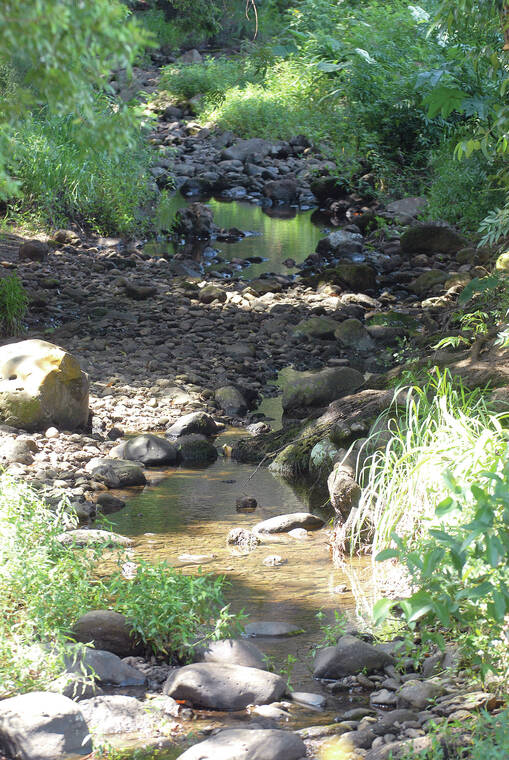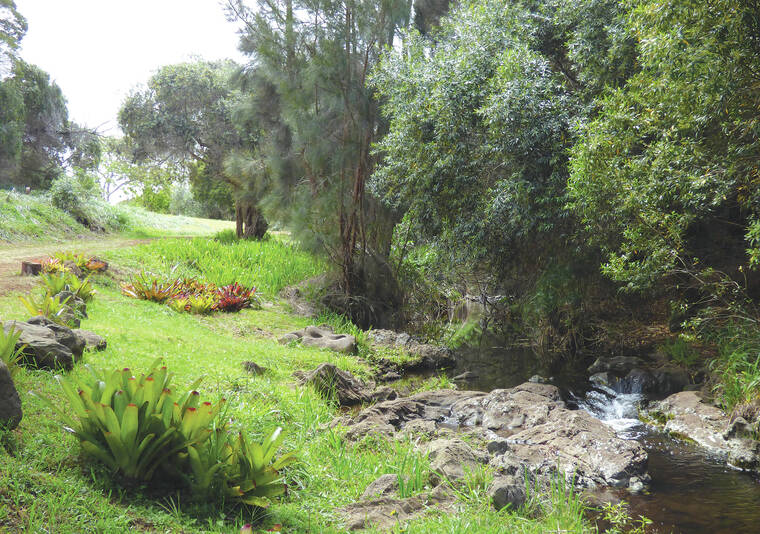The public is invited to provide feedback on Thursday about a recommendation for partial stream flow restoration for the Waikoloa Stream in South Kohala.
In the March meeting of the state Commission on Water Resource Management, hydrologist Ayron Strauch presented information about the stream, its current status and proposed solutions.
Strauch presented information from the commission’s Draft Instream Flow Assessment Report. He said instream flow standards measure the quality, depth and quantity of water that is needed in a stream to preserve, enhance or restore the stream to provide for uses including fish and wildlife habitat, recreation, ecosystem maintenance, water quality and Hawaiian traditional and customary rights.
The Waikoloa and Kohakoohau streams originate above the 4,000 foot elevation on Kohala Mountain and flow relatively parallel to one another until they join in a series of braided channels at about the 1,440-foot elevation to form Wai‘ula‘ula, which flows into Pelekane Bay in Kawaihae.
Both streams have been partially diverted for decades by the Department of Water Supply into four reservoirs through a pipeline. DWS has the capacity of diverting 4.1 million gallons per day from Waikoloa Stream to provide drinking water from Waimea to Kawaihae, but has reported use at 1.47 mgd. The reservoirs have over 150 million gallons of storage, although one 50 million gallon reservoir currently is in need of repair.
DWS has two wells in the area to supplement the water supply — the Waimea deepwell and Parker Ranch deepwell — however, they have not pumped much groundwater over the last 10 years, instead relying on the stream water. Those wells are capable of producing 2.16 mgd.
Parker Ranch also diverts 1.35 mgd from the Waikoloa Stream for agricultural use.
According to Strauch, both streams that feed into it are perennial, meaning they have continuous flow of surface water throughout the year. That flow supports surrounding agriculture and freshwater life. Waikoloa Stream is one of the few streams that still exist on the west side of the island that would run mauka to makai if restored.
The commission’s goal is to protect the stream’s flow by making sure at least 0.4 mgd flows from mauka to the ocean. In order to meet that goal, Strauch said they would need to compensate for the groundwater seepage below the DWS system, needing approximately 1.4 mgd flow below the intake.
Strauch said that can be met through structural modifications and would continue to meet DWS water needs from the stream.
He also noted the Upper Hamakua Ditch pipeline runs to the reservoirs is another alternative. However, it is not in use and in need of repair.
According to the assessment, the stream can support native freshwater species such as o‘opu (Hawaiian freshwater goby) and ‘opae (freshwater shrimp) among other aquatic life.
The area includes the Lalamilo Field system, one of the largest intact archaeological sites, as well as, an extensive ‘auwai system (an open channel of water that connects a river to a taro patch or fishpond) for wetland kalo production.
Strauch said that many families are interested in reestablishing the ‘auwai system below the Lalamilo Farm Lots for both dryland and wetland kalo, but there has not been a continuous enough flow to be utilized. Strauch said the ‘auwai system is quite extensive in the area.
The commission also is meeting with the Department of Hawaiian Home Lands to make sure its water needs are met.
The Department of Health, EPA, NOAA Coral Shelf Conservation, the Nature Conservancy and Hawaii Division of Aquatic Resources have identified the watershed as important for restoration to reduce sediment and nutrient pollution running off into Pelekane Bay, which can damage habitats, deplete oxygen from the water which harms marine life, and can lead to toxic algal blooms.
“After more than 70 years of diversion, it is time to restore mauka to makai flows to the Waikoloa Stream,” said Kamanamaikalani Beamer, UH director of Kamakakuokalani Center for Hawaiian Studies. “A substantial amount of water has been wasted and left in reservoirs that should have been left in the stream. With the data gathered and reported by (the Commission on Water Resource Management), it is clear it is time to share the water with the stream and community, and there is enough water to meet county and other off-steam demands and uphold public trust usages of water for the stream and community. Restoring the Waikoloa Stream will improve the ecosystem health of our coast and stream while providing life back to the community.”
An inventory of best available information, agency review and public comment will be incorporated and submitted to the commission, with recommendations within the next few months.
The commission will hold a public comment and fact-gathering meeting at 5:30 p.m. Thursday at the Waimea Community Center.
From there, the Instream Flow Standard Assessment report will be updated, public testimony compiled, and recommendations made.








